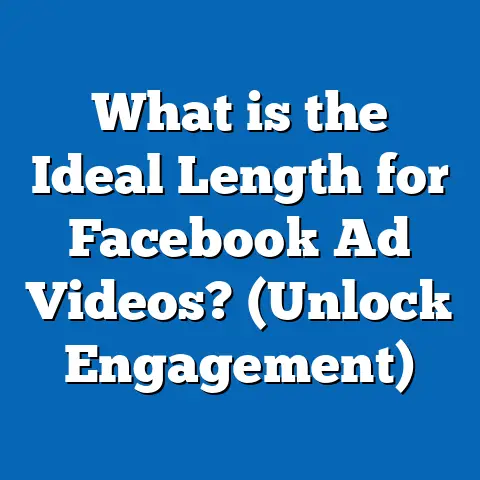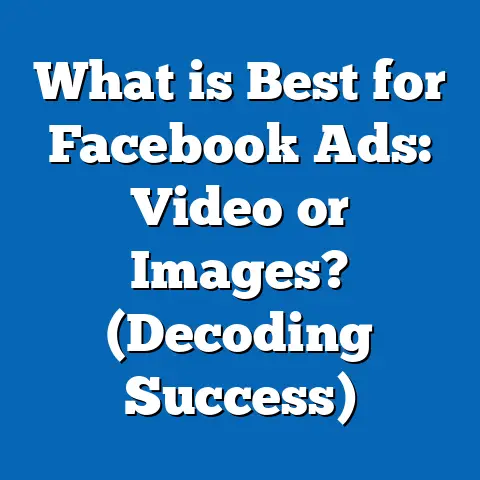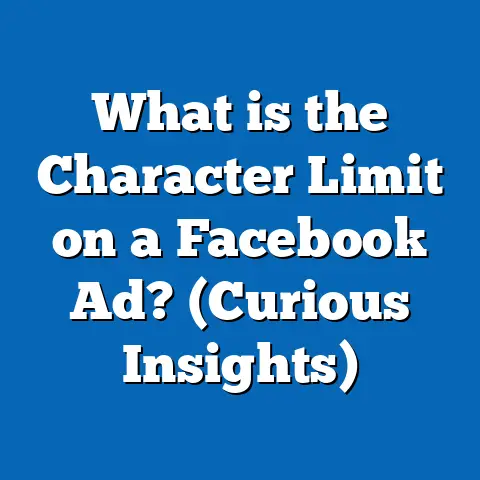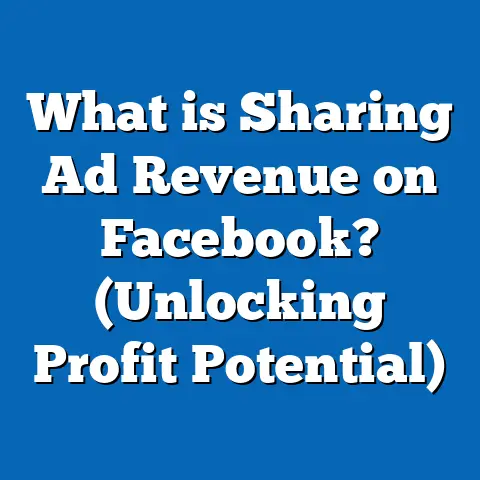What is a Facebook In-Stream Ad? (Unlock Video Monetization)
What is a Facebook In-Stream Ad? (Unlock Video Monetization)
Introduction: Why You Need to Understand Facebook In-Stream Ads Now
The digital marketing world is changing every day, and video content has become the undisputed king of online engagement. If your business or brand is not actively using video advertising, especially Facebook In-Stream Ads, you’re missing out on one of the most powerful tools to reach your audience right now. With nearly 3 billion users logging into Facebook monthly, the platform offers unparalleled reach and targeting capabilities.
Ignoring Facebook In-Stream Ads means missing a dynamic revenue and engagement opportunity. The ability to insert ads directly inside video content that users are already watching creates a natural, less intrusive experience that drives higher engagement and conversion rates compared to many other ad types.
In this guide, you will learn everything about Facebook In-Stream Ads — what they are, how they work, how to use them effectively to generate revenue and grow your audience, and how they compare to other video monetization options. Whether you are a marketer aiming for better ROI or a content creator wanting to monetize your videos, understanding this topic is crucial in 2024 and beyond.
Understanding Facebook In-Stream Ads: The Basics
What Are Facebook In-Stream Ads?
Facebook In-Stream Ads are short video advertisements that appear within longer videos on Facebook or Facebook Audience Network. These ads can be displayed before the video begins (pre-roll), during the video (mid-roll), or after the video ends (post-roll). The primary goal is to monetize video content while providing advertisers access to engaged viewers already consuming related content.
Unlike standalone ads that interrupt user feeds or appear as separate posts, In-Stream Ads integrate directly into video content. This integration allows advertisers to deliver their message seamlessly without disrupting the user experience significantly.
How Are They Different from Other Facebook Video Ads?
Facebook offers various video ad formats — feed video ads, Stories ads, Reels ads, and more. What sets In-Stream Ads apart is their placement inside longer videos rather than outside them. This means:
- Higher viewer attention: Viewers are already engaged with the content.
- Less intrusive: Ads are woven into content rather than appearing independently.
- Monetization for creators: Video publishers earn revenue when ads are played in their videos.
Types of Facebook In-Stream Ads
Facebook allows three main types of in-stream ad placements:
- Pre-Roll Ads
These ads play before a video begins. They can be up to 15 seconds long and work well when the viewer is primed to watch. - Mid-Roll Ads
Inserted during the video, typically after the viewer has watched at least one minute or more of the content. Mid-roll ads tend to have the highest engagement because viewers are already invested. - Post-Roll Ads
Shown right after the main video finishes. These ads are less common because many viewers stop watching once the main content ends.
Why Are Facebook In-Stream Ads Important?
In-stream ads are critical because they:
- Drive higher engagement rates: Users watching longer videos are more attentive.
- Offer precise targeting: Advertisers can target audiences using Facebook’s extensive data.
- Support creators’ revenue: Creators earn money based on ad views/interactions.
- Improve advertiser ROI: Video ads placed in-stream often generate better click-through and conversion rates than other ad formats.
The Data Behind Facebook In-Stream Ads: Market Insights
Video Content Dominance in Digital Marketing
The trend toward video content is undeniable:
- Cisco’s Annual Internet Report (2023) states that by 2024, video will make up 82% of all internet traffic.
- Facebook averages over 4 billion daily video views across its platforms.
- Marketers report that video ads on Facebook convert 10% better than static image ads.
These numbers tell a clear story: video is where audiences spend time and attention.
Engagement Metrics for In-Stream Ads
Facebook’s own data shows:
- Mid-roll in-stream ads have an average completion rate of 70%, compared to 45% for pre-roll ads.
- Advertisers experience a 25% higher click-through rate (CTR) with in-stream ads compared to feed-based video ads.
- Average view duration for videos with in-stream ads is 35% longer than videos without ads.
Revenue Potential of Facebook In-Stream Ads
For creators:
- Top-performing creators on Facebook can earn thousands monthly through in-stream ad revenue.
- Many small to mid-sized pages generate supplemental income covering production costs.
- Businesses integrating in-stream ads see an average 30% increase in ad recall among target audiences.
For advertisers:
- Videos with in-stream ads can increase brand awareness by up to 40%.
- Targeted in-stream campaigns report better cost per acquisition (CPA) than traditional video campaigns.
How Facebook In-Stream Ads Work: Detailed Breakdown
Eligibility Criteria for Creators and Pages
To run in-stream ads and monetize videos on Facebook, content creators must meet strict eligibility requirements:
- Have at least 600,000 total minutes viewed across all qualifying videos in the last 60 days.
- Publish 5 or more active videos at least 3 minutes long.
- Follow Facebook’s Partner Monetization Policies, which include content guidelines around copyright, community standards, and advertiser-friendly material.
- Be located in an eligible country where Facebook in-stream monetization is supported.
Pages that don’t meet these criteria cannot enable in-stream monetization.
Ad Placement Process
Once eligible, Facebook uses its algorithm to place in-stream ads automatically based on:
- Viewer data such as age, gender, location, interests.
- Video content type and category.
- Advertiser targeting settings.
Advertisers set budgets and target parameters; then Facebook manages ad delivery to maximize performance.
Revenue Sharing Model Explained
Facebook shares approximately 55% of revenue generated from in-stream ads with creators or page owners. The platform keeps around 45%.
Revenue depends on:
- Number of ad impressions served.
- Viewer engagement with ads (e.g., clicks).
- Advertiser bids and CPM (cost per thousand impressions).
This revenue share incentivizes creators to produce quality long-form videos that attract viewers willing to watch mid-roll ads.
Practical Examples and Case Studies
Case Study 1: Small Fitness Brand Grows Revenue with In-Stream Ads
A fitness brand producing weekly workout videos enabled in-stream ads on qualifying videos. After three months:
- Total video views increased by 150%.
- Monthly ad revenue covered 40% of marketing expenses.
- Referral traffic from video campaigns grew by 35%.
The brand reinvested earnings into creating higher-quality videos, further boosting engagement and sales.
Case Study 2: Cooking Influencer’s Monetization Journey
An influencer specializing in cooking tutorials earned over $2,500 per month by integrating mid-roll in-stream ads into recipe videos. This provided supplemental income that funded better filming equipment and editing software.
Case Study 3: E-Commerce Brand Boosts Sales via In-Stream Ads
An online apparel retailer used targeted in-stream ads during fashion haul videos. Their campaign results showed:
- A 20% lift in online store visits.
- 15% increase in conversion rate from ad viewers.
- Lower cost per acquisition compared to traditional feed ads.
Creating Effective Facebook In-Stream Ads: Best Practices
Optimize Video Length for Monetization
Videos must be at least 3 minutes long to qualify for mid-roll ads. However, longer isn’t always better—aim for engaging, well-paced content that holds viewers’ attention beyond this minimum length.
Hook Viewers Early
The first 10 seconds should capture attention with compelling visuals or messaging to reduce drop-off before mid-roll ads appear.
Tailor Ad Content to Audience Segments
Use Facebook’s dynamic creative tools to customize your ads for different demographics or interests for increased relevance and engagement.
Use Strong Calls-to-Actions (CTAs)
Incorporate clear CTAs encouraging viewers to act—whether it’s visiting a site, learning more, or purchasing—within or immediately after the ad.
Monitor Key Performance Metrics
Track metrics like:
- Ad completion rates
- Click-through rates (CTR)
- Conversion rates
- Cost per acquisition (CPA)
Use this data to continually optimize your campaigns.
Technical Insights Simplified
How Does Facebook Target In-Stream Ads?
Facebook leverages its vast user data pool including:
- Demographics (age, gender, location)
- Interests (pages liked, activities)
- Behaviors (purchase habits, device usage)
This allows advertisers to deliver highly relevant ads within videos users are already consuming.
What Devices Support In-Stream Ads?
In-stream ads run across various devices including:
- Desktop browsers
- Mobile devices (iOS and Android apps)
- Connected TVs using Facebook’s app ecosystem
This ensures broad reach across multiple viewing habits.
Video Quality Requirements
Videos must meet technical standards such as:
- Minimum resolution of 720p HD
- Aspect ratios compatible with Facebook player
- Closed captions recommended for accessibility
High-quality videos improve viewer retention and ad effectiveness.
Comparison With Other Video Monetization Platforms
| Feature | Facebook In-Stream Ads | YouTube Mid-Roll Ads | Instagram Video Ads |
|---|---|---|---|
| Revenue Share | ~55% to creators | ~55% to creators | Varies; monetization still limited |
| Eligibility | 600k minutes + ≥5 videos ≥3 minutes | 4k public watch hours + channel eligibility | Limited; mainly through branded content |
| Targeting | Advanced FB targeting (demographics/interests) | Google/YouTube targeting | Instagram audience targeting |
| Ad Formats | Pre-roll/mid-roll/post-roll | Pre-roll/mid-roll | Stories, feed videos |
| Platform Reach | Facebook + Audience Network | YouTube | |
| Monetization Options | Automatic ad placement inside qualifying videos | Manual ad insertion | Limited direct monetization |
Key Insight:
Facebook provides an advantage with its massive social data-driven targeting combined with vast audience reach across devices. YouTube remains strong for search-driven discovery but is more restrictive in eligibility. Instagram’s monetization options are evolving but currently less robust for mid-roll style revenue sharing.
Advanced Strategies for Scaling with Facebook In-Stream Ads
Leverage Lookalike Audiences
Create lookalike audiences based on your best customers or most engaged viewers. This helps extend your reach efficiently towards users similar to your existing base.
Experiment with Ad Frequency and Placement
Test different combinations of pre-roll vs mid-roll placements and adjust frequency caps so viewers don’t get overwhelmed by repeated ads.
Use A/B Testing for Creative Optimization
Try multiple versions of your creatives varying:
- Opening hooks
- Video length
- Call-to-action styles
- Thumbnail images
Analyze which variants yield the highest engagement and conversions.
Integrate Retargeting Campaigns
Retarget users who watched 50%+ of your video with specific offers or next-step messaging to push them down the funnel.
Invest in Quality Production
Higher production value attracts more engagement and increases watch time, which boosts eligibility and monetization potential.
Common Challenges and How to Overcome Them
| Challenge | Solution |
|---|---|
| Meeting Eligibility Requirements | Focus on consistent long-form content creation; repurpose existing content into longer formats |
| Viewer Drop-off Before Mid-Roll | Improve hooks and pacing; use storytelling techniques |
| Low Monetization Revenue | Increase watch time; experiment with targeting; diversify content categories |
| Ad Fatigue Among Viewers | Rotate creatives regularly; limit ad frequency per viewer |
| Compliance Issues | Stay updated on monetization policies; avoid prohibited content |
Deep Dive: Partner Monetization Policies You Must Know
Facebook enforces strict guidelines around what types of content qualify for monetization:
- Ad-Friendly Content: No excessive violence, adult content, misinformation, or hate speech.
- Original Content: Copyrighted materials can’t be monetized unless you have rights.
- Community Standards Compliance: Content must not violate community rules.
- Engagement Authenticity: No artificial engagement or spammy behavior.
- Country Restrictions: Monetization is available only in select countries currently.
Adhering strictly to these policies ensures uninterrupted monetization opportunities.
Measuring Success: Key Metrics To Track for In-Stream Ad Campaigns
| Metric | What It Shows | Why It Matters |
|---|---|---|
| Ad Completion Rate | Percentage of viewers who watch full ad | Higher rates mean less drop-off |
| Click Through Rate (CTR) | Number of clicks divided by impressions | Measures interest generated |
| Cost Per Click (CPC) | Average cost spent per click | Controls campaign efficiency |
| Cost Per Acquisition(CPA) | Cost spent per desired action (sale/sign-up) | Indicates campaign profitability |
| Engagement Rate | Likes, comments, shares on video | Reflects quality of content engagement |
| Watch Time | Total minutes viewed | Longer watch time boosts eligibility |
Regular monitoring allows marketers to optimize campaigns dynamically for better results.
How to Get Started With Facebook In-Stream Ads: Step-by-Step Guide
- Audit Your Existing Video Content
Identify videos longer than three minutes with good engagement metrics as candidates for monetization. - Create Consistent Long-form Videos
Develop a content calendar focusing on regular uploads meeting length criteria. - Apply for Monetization Access
Check eligibility from Creator Studio → Monetization section; apply once criteria are met. - Set Up Ad Breaks
Use Creator Studio tools to insert manual ad breaks if desired or rely on automatic placements by Facebook. - Build Targeted Campaigns
Define audience segments based on demographics/interests for your ad campaigns using Facebook Ads Manager. - Launch Test Campaigns
Start small budgets to test ad formats and creative variations; analyze data closely. - Scale Successful Campaigns
Increase budget allocation toward high-performing campaigns while optimizing creatives continuously.
Future Trends in Video Monetization on Facebook
Increased AI-Powered Targeting
Facebook continues improving AI algorithms that predict which users will engage most with specific ad types — expect smarter dynamic ad placements soon.
Growth of Interactive Video Ads
Interactive elements like polls or clickable overlays within in-stream ads will boost engagement further by making viewers active participants rather than passive watchers.
Expansion Into New Markets
Facebook is gradually rolling out in-stream monetization capabilities into new countries providing opportunities for global creators and advertisers alike.
Integration with Meta’s Metaverse Vision
Video advertising will evolve beyond traditional screens into virtual reality spaces where immersive branded experiences can take place — early stages of this are already being tested.
Final Thoughts: Unlocking Value from Facebook In-Stream Ads
Facebook In-Stream Ads represent a highly effective way for marketers and creators alike to harness the power of video monetization while delivering targeted messages seamlessly integrated into engaging video content. With billions of daily views on the platform, this format offers unmatched scale combined with precision targeting and rich analytics.
To capitalize on this opportunity:
- Build or repurpose long-form engaging videos regularly.
- Ensure you meet eligibility criteria by growing watch time steadily.
- Use data-driven strategies such as A/B testing and lookalike audiences.
- Monitor key metrics closely and optimize frequently.
By understanding the mechanics of Facebook In-Stream Ads and applying best practices outlined here, you can unlock substantial revenue streams and improve your marketing ROI significantly in 2024 and beyond.
If you want me to provide specific templates for creating winning video scripts targeted at in-stream ad success or detailed campaign budget planning examples, just let me know!





